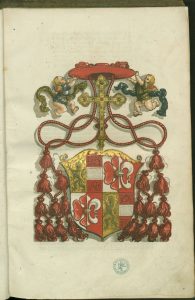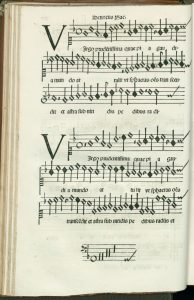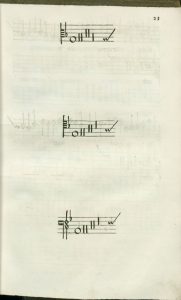4.2 Examples
A fine example of music prints that are really intended primarily to transmit the musical text are the songbooks from the Egenolff print shop in Frankfurt. The part books have a plain title page, a legible but not particularly carefully crafted musical notation and usually come without any prefaces or dedications.
 56 German Partsongs, Frankfurt (Christian Egenolff), c. 1535.
56 German Partsongs, Frankfurt (Christian Egenolff), c. 1535.
Munich, Bavarian State Library, Mus.pr. 46#Beibd. 2, Tenor fol. 2.
Click here to access the full digitized source.
An extreme counterexample from the second half of the 16th century is the choirbook series Patrocinium Musices, which was printed mainly in the 1570s by Adam Berg in Munich. The volumes each contain works by a composer from the Munich court chapel - especially those by Orlando di Lasso - and their dedications are addressed to high-ranking nobles in the environment of the Munich ducal court. The title pages are splendidly decorated, as are the initials on the music pages. Adam Berg even had his own typeface for printing the choirbooks, which not only looks particularly clean, but also has a special size to enable optimal readability.
For an image of one of the Patrocinium Musices-choirbooks see section 3.1 Choirbooks and partbooks.
Click here to access the full digitized source.
The Liber selectarum cantionum is another example for a splendid choirbook-print. It was printed in 1520 in the Grymm & Wyrsung workshop in Augsburg and probably commissioned by the music- and art enthusiast Emperor Maximilian I. Sadly, he passed away before the Liber selectarum could be finished. The choirbook contains motets (Latin spiritual compositions) by composers affiliated with Maximilian’s court chapel (or, at least, the chapel’s repertoire). Some copies even come with a colourful printed coat of arms of the Salzburg bishop and cardinal Matthias Lang von Wellenburg, who was very close with the emperor and is also the dedicatee of the choirbook. Everything indicates that the book was produced as a real showpiece for a small target group. The entire history around the book was reviewed in an essay by Elisabeth Giselbrecht and Elizabeth Upper (see further reading).

Coat of arms of the dedicatee, Matthäus Lang von Wellenburg (fol. 2r).


First opening of Heinrich Isaac's motet Virgo prudentissima (fol. 22v-23r)
Liber selectarum cantionum, Augsburg (Grymm & Wyrsung), 1520.
Regensburg, State Library/University Library, 999 IM/2Liturg.69.
Click here to access the full digitized source.